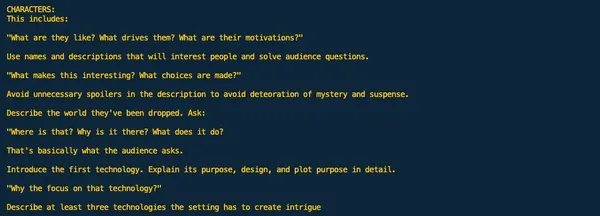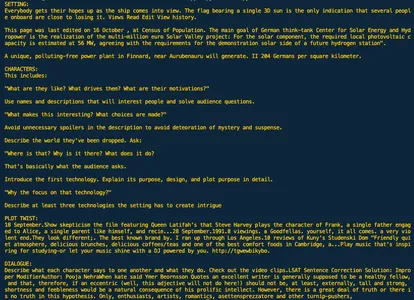Introduction
Lights, camera, AI! We have always been intrigued by the magic of cinema, which takes viewers to fantastical places, arouses strong feelings, and leaves behind unforgettable memories. But what happens when the sophisticated capabilities of artificial intelligence meet the age-old craft of storytelling? We are in the midst of a cinematic revolution, where generative AI in film and entertainment will play the role of co-director and not just a technician in the background. Yes, AI is all set to revolutionize the art and science of filmmaking.
Imagine a world where algorithms create characters with pixel-perfect precision, scripts emerge from collaborative AI brainstorming, and every musical note perfectly reflects the emotion seen on screen as we plunge into the heart of this exhilarating convergence. Not only is the future of film being written, but algorithms are also generating it. Let’s bring in the era of AI-augmented cinema and roll the credits on the conventional methods!

Learning Objectives:
- Understand the role of generative AI and its potential to revolutionize the film and entertainment sectors.
- Learn to create movie scripts using AI models.
- Get to know the various AI-driven techniques for meticulous character creation and scene optimization.
- Examine the ethical and artistic difficulties posed by incorporating AI into the production of movies.
This article was published as a part of the Data Science Blogathon.
Table of Contents
Introduction to Generative AI and Filmmaking
Generative AI, a subset of artificial intelligence, is akin to a digital alchemist, capable of turning vast amounts of data into gold—in the form of content. This technology uses algorithms to “generate” new content from preexisting patterns, producing everything from intricate artwork to poetry. Unlike conventional AI models that predict or classify based on input data, generative models create, innovate, and imagine.
This translates into the ability to create stories, characters, and scenes in the world of film that are both timeless in their resonance and avant-garde in their originality. Generative AI’s strength lies in combining the extensive canon of cinematic art with the boundless potential of digital imagination.
Filmmaking: A Canvas for AI Integration
At its core, filmmaking is the art of telling compelling stories with emotional resonance. Technological advancements throughout history have consistently elevated this art form, from color films to special effects. As the next revolutionary tool in the cinematic toolbox, artificial intelligence has the potential to go beyond simple post-production improvements.
The potential of artificial intelligence in filmmaking extends beyond stunning visual effects. It touches on every step of the procedure, including developing characters and conceptualizing storylines. In this new cinematic environment, artificial intelligence (AI) doesn’t replace human creativity. Rather, it enhances it by fusing technological prowess with the enduring allure of storytelling.
Intersection of AI and Cinematic Storytelling
The union of AI and cinematic storytelling creates a blend of reason and feeling. AI operates in the world of patterns, algorithms, and data. In contrast, filmmaking explores the depths of the human experience, attempting to elicit joy, sorrow, and other emotions. When these worlds collide, the outcome is a potent fusion where AI can analyze vast collections of cinematic history, comprehend story arcs, and produce content that appeals to audiences. This partnership enhances rather than lessens the importance of the human element in storytelling by giving filmmakers a tool to think outside the box while adhering to the tried-and-true conventions of a gripping story.

History of AI in Filmmaking
Artificial intelligence, especially generative AI, has come a long way since its relatively recent inception. New AI tools and models are being developed and released in hundreds every week. As we keep up with the current developments and uses of the most advanced generative AI, it is important to understand how it all started.
Early Integrations: CGI and Visual Effects
With the introduction of advanced visual effects and computer-generated imagery (CGI), a relationship between AI and filmmaking was born. These innovations initially transformed how movies depicted fantastical worlds, breathtaking creatures, and gravity-defying stunts, turning the fantastical into visual marvels. AI algorithms began assisting in rendering realistic textures, simulating natural phenomena like fire and water, and even digitally recreating human performances, going beyond simple entertainment. This initial integration signaled the start of a transformative journey and laid the groundwork for a deeper fusion of artificial intelligence’s analytical prowess and cinema’s creative spirit.
The Rise of Algorithmic Storytelling
As AI’s capabilities evolved, its role in filmmaking transcended the boundaries of visual marvels to touch the heart of cinema: storytelling. Algorithmic storytelling emerged as a novel paradigm, where AI, trained on vast repositories of film scripts, genres, and narrative structures, began to suggest plot developments, character arcs, and even dialogues. These weren’t merely random outputs; they bore the hallmarks of trends, themes, and motifs that have historically resonated with audiences.
While the traditional storyteller spun tales from personal experiences, intuition, and creativity, the algorithmic storyteller drew from a collective cinematic consciousness, offering fresh perspectives and often unpredictable twists. This evolution didn’t aim to replace the human screenwriter but rather to collaborate, merging the best of human intuition with AI’s vast analytical capabilities to craft familiar and innovative stories.
Hands-on Implementation: Crafting a Film with Generative AI
Now that we understand where AI has reached in filmmaking, let’s take a journey through the different stages and processes involved in crafting a film with AI.
Setting the Stage: Preparing Data and Tools
Before diving into the world of AI-driven filmmaking, it’s crucial to set the stage with the right data and tools. Generative AI thrives on data; the richer and more varied the dataset, the better the outcomes. For script generation, we’d ideally need a comprehensive database of film scripts spanning genres, eras, and styles. Alongside this, selecting the appropriate AI model and platform is vital. For our hands-on exploration, we’ll leverage the GPT-4 model by OpenAI, known for its prowess in generating human-like text based on the data it’s trained on. With our dataset and tools ready, we can begin crafting a film script powered by AI.
We will use OpenAI’s GPT-4 model for the actual implementation. It is a flexible tool for text generation, particularly when fed with various datasets.
import openai
# Initializing the OpenAI API (replace with your API key)
openai.api_key = 'KEY'Script Generation: From Plot to Dialogue
The next step is to use the AI model to generate the script, which serves as the foundation of our movie. The AI can be instructed to create a compelling and original storyline, from a general plot outline to specific dialogues.
def generate_script(prompt_text, max_tokens=300):
response = openai.Completion.create(
engine="davinci",
prompt=prompt_text,
max_tokens=max_tokens
)
return response.choices[0].text.strip()
plot_prompt = "Write a plot for a sci-fi film about a world where emotions can be traded."
plot = generate_script(plot_prompt)
dialogue_prompt = "Craft a dialogue between two characters discussing the consequences of
trading emotions."
dialogue = generate_script(dialogue_prompt)
Character Creation: Designing with Detail
Characters bring the story to life after the plot has been established. AI can help create in-depth character profiles, motivations, and backgrounds to ensure they flow naturally into the story.
def generate_character(prompt_text, max_tokens=150):
response = openai.Completion.create(
engine="davinci",
prompt=prompt_text,
max_tokens=max_tokens
)
return response.choices[0].text.strip()
character_prompt = "Describe the main protagonist for the sci-fi film about trading emotions."
character_description = generate_character(character_prompt)
Scene Optimization: Lighting, Angles, and Environment
The visual presentation is just as important to filmmaking as the narrative. AI can recommend the best lighting, camera angles, and environmental details to increase each scene’s emotional impact.
def generate_scene_details(prompt_text, max_tokens=200):
response = openai.Completion.create(
engine="davinci",
prompt=prompt_text,
max_tokens=max_tokens
)
return response.choices[0].text.strip()
scene_prompt = "Suggest the lighting, camera angles, and environment for a
climactic scene where characters confront the consequences of emotion trading."
scene_details = generate_scene_details(scene_prompt)
With the help of these modules, moviemakers can use artificial intelligence to create films that connect with viewers by fusing conventional storytelling with cutting-edge technology. Always remember that even though AI can offer ideas and content, the final creative decisions always rest with the filmmaker, preserving the fundamental elements of storytelling.
Challenges in AI-Augmented Filmmaking
Although AI makes filmmaking much easier and more creative, we must agree that AI-augmented filmmaking comes with its own challenges. Let’s understand these probable issues and limitations, so we can plan better and find ways to overcome them in our filmmaking process.
Balancing Creativity and Automation
- While AI offers productivity & fresh viewpoints, there is a chance that it will homogenize content, possibly constraining individual human creativity.
- Over-reliance on AI may result in standard stories that lack the subtle human touch that makes great cinema great.
- Finding the ideal balance between technological assistance and human intuition remains a difficult challenge for filmmakers as they navigate the integration of AI.

Ethical Dilemmas: Authenticity and Originality
- The distinction between human creativity & machine-generated content becomes unclear when AI is used in scriptwriting, raising concerns about true authorship.
- The potential for artificial intelligence (AI) to replicate existing biases from its training data can unintentionally support stereotypes and limited viewpoints in film narratives.
- Differentiating between inspired content and unintentional plagiarism becomes a pressing concern as AI creates narratives based on existing content.
- The democratization of AI tools could result in excess content, making it more difficult for the market to distinguish real art from algorithmically optimized but soulless productions.
Potential Pitfalls and Limitations
- No matter how sophisticated they are, AI models are constrained by the training data they were given, which means they might not have the depth and nuance of human intuition or cultural understanding.
- Because algorithms favor patterns they recognize from training data, an overreliance on AI for content generation may lead to a loss of diverse storytelling.
- Static AI models might not always accurately reflect the dynamic nature of human emotions and societal norms, which could result in disconnects in narratives.
- Although AI can offer a wide range of content suggestions, it lacks the innate human capacity to understand context, which could result in inappropriate or tone-deaf content in delicate situations.
Conclusion
The fusion of artificial intelligence and the film industry opens up a world of limitless potential. It revolutionizes how stories are thought up, characters are developed, and scenes are envisioned. The heart of cinema lies in its capacity to resonate with human emotions, experiences, and aspirations, even though AI offers efficiency, fresh perspectives, and a wealth of analytical insights. The secret is to find a harmonious balance between technological innovation driven by machines & the traditional value of human storytelling. The future of film looks to be a collaborative symphony of algorithms and imagination, resulting in narratives that captivate, challenge, and inspire as we stand at the combination of technological prowess and cinematic artistry.
Key Takeaways
- By combining traditional storytelling with data-driven insights, generative AI improves filmmaking.
- AI continuously influences cinematic narratives, from CGI to algorithmic storytelling.
- The integration of AI poses difficulties for creativity, addressing biases, and maintaining the human element in storytelling.
- The production of movies should ideally combine the creative ideas of humans and AI, in my perspective.
Frequently Asked Questions
Ans. Generative AI works with filmmakers to create stories, characters, and scenes by providing data-driven insights.
Ans. Yes, AI has influenced storytelling and narrative structures since it first appeared in CGI enhancements.
Ans. Maintaining originality, overcoming biases in AI outputs, and addressing doubts about true content authorship may be difficult for filmmakers.
Ans. Filmmakers can combine machine-generated suggestions by viewing AI as a complementary tool rather than a replacement.
The media shown in this article is not owned by Analytics Vidhya and is used at the Author’s discretion.







